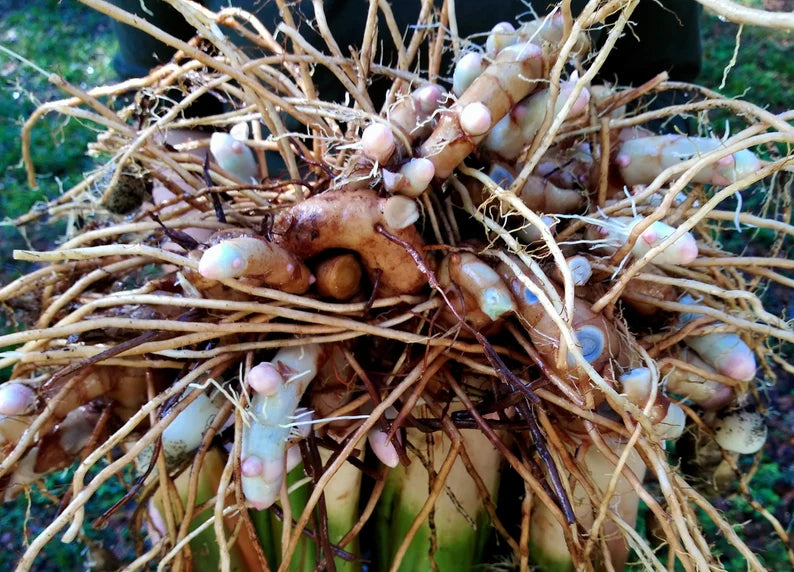
Black Turmeric: The Mysterious Spice
Share
Black turmeric, often referred to as Curcuma caesia or black zedoary, is a lesser-known cousin of the vibrant yellow turmeric we're all familiar with. This intriguing spice hails from the ginger family and boasts a captivating dark hue, distinct aroma, and a range of potential health benefits. Let's delve into the world of black turmeric.
What is Black Turmeric?
Unlike its yellow counterpart, black turmeric is a rare find. Its rhizomes, the underground stems, are the part used for culinary and medicinal purposes. They have a slightly sweet, earthy aroma and a flavor that's peppery and slightly bitter.
Potential Health Benefits
While research is still ongoing, traditional medicine has long attributed various health benefits to black turmeric. Some of these include:
- Anti-inflammatory properties: Like its yellow cousin, black turmeric contains compounds with potential anti-inflammatory effects.
- Digestive aid: Traditionally used to support digestion, black turmeric may help alleviate digestive discomfort.
- Skin health: Some believe it can promote healthy skin due to its antioxidant properties.
- Respiratory support: Black turmeric has been used to address respiratory issues like cough and asthma.
Disclaimer: It's important to note that while these claims are based on traditional use and some preliminary studies, more scientific research is needed to confirm these benefits.
Growing Black Turmeric: A Guide to Cultivating the Mysterious Spice
Intrigued by the dark allure of black turmeric and its potential health benefits? You might be considering growing your own! While it thrives in its native Southeast Asian climate, with proper care, you can cultivate this exotic plant right in your own backyard. Here's what you need to know:
Before You Begin:
Black turmeric is a slow-growing perennial that requires warm, humid conditions. It's best suited for zones 9-11 (USDA Hardiness Zone Map). If your climate isn't ideal, you can try growing it in a container indoors with proper light and humidity control.
What You'll Need:
- Black Turmeric Rhizomes: Since black turmeric seeds are hard to come by, you'll need to start with rhizomes, the underground stems used for propagation. Luckily, you can find high-quality black turmeric rhizomes sourced right here in Australia at SEEDS N BEYOND (seedsnbeyond.com.au)!
- Potting Mix: Choose a well-draining, fertile potting mix rich in organic matter.
- Pot: Opt for a container at least 12 inches deep and wide to allow for root growth.
- Location: For outdoor planting, select a warm, sheltered location with partial shade. Avoid direct afternoon sun, especially in hot climates. If growing indoors, find a bright spot with indirect sunlight and good humidity.
Planting Instructions:
- Prepare the Pot: Fill your chosen container with the well-draining potting mix.
- Planting the Rhizome: Gently push the black turmeric rhizome eye-side up about 2-3 inches deep into the soil.
- Watering: Water thoroughly to settle the soil and keep the potting mix consistently moist but not soggy.
- Mulching: Apply a thin layer of organic mulch around the base of the plant to retain moisture and suppress weeds.
Ongoing Care:
- Watering: Keep the soil consistently moist, especially during the growing season. Water deeply when the top inch of soil feels dry. Avoid overwatering, which can lead to rot.
- Fertilizing: Feed your black turmeric plant with a balanced organic fertilizer once a month during the growing season.
- Temperature: Black turmeric thrives in warm temperatures between 68-86°F (20-30°C). Protect it from frost if planted outdoors.
- Humidity: Maintaining good humidity is essential. Mist the plant regularly or use a pebble tray filled with water to increase humidity levels around the plant.
Harvesting Your Black Turmeric:
Black turmeric can take 8-10 months to mature before being ready for harvest. Signs of maturity include yellowing or dying foliage. Carefully dig up the entire plant and separate the rhizomes. You can replant a portion of the rhizomes to continue growing your black turmeric stock.
Important Note: Remember, black turmeric is primarily used for its rhizomes, not its flowers. While it may produce beautiful flowers, the focus should be on nurturing the underground growth.
Ready to embark on your black turmeric growing adventure? Head over to SEEDS N BEYOND (seedsnbeyond.com.au) and grab your high-quality black turmeric rhizomes today! With a little patience and care, you'll be enjoying the unique flavor and potential health benefits of this exotic spice in no time.
